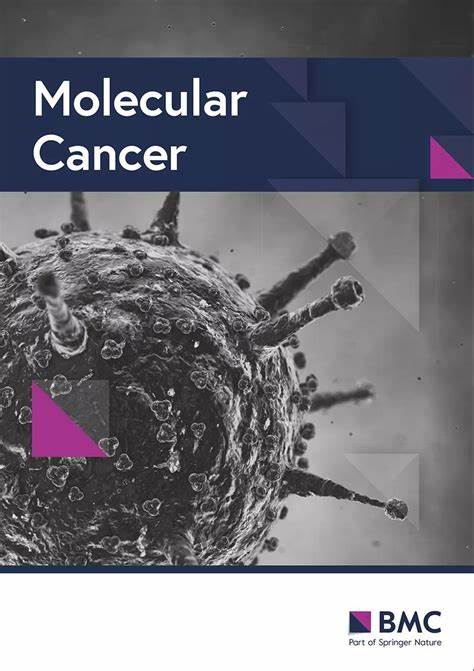Targeting FGFR4 abrogates HNF1A-driven metastasis in pancreatic ductal adenocarcinoma
IF 33.9
1区 医学
Q1 BIOCHEMISTRY & MOLECULAR BIOLOGY
引用次数: 0
Abstract
We previously identified an oncogenic role for the transcription factor HNF1A in pancreatic ductal adenocarcinoma (PDAC). However, the role of HNF1A in the metastatic progression of PDAC remains unknown and targeting modalities for HNF1A-dependent phenotypes have yet to be identified. Transwell chambers were used to assess the effects of HNF1A and FGFR4 modulation on the migration and invasion of ATCC and patient-derived PDAC cells in vitro. An intrasplenic injection xenograft model was used to evaluate the impact of HNF1A knockdown and overexpression on metastatic tumor burden. Single-cell RNA sequencing (scRNA-seq), tissue microarray (TMA) data, and UMAP spatial profiling were used to identify FGFR4 as an HNF1A target gene upregulated in metastatic cells. RNAi and two FGFR4 inhibiting modalities (H3B-6527 and U3-1784) were utilized to demonstrate the efficacy of FGFR4 inhibiting agents at reducing HNF1A-driven metastasis. Knockdown of HNF1A significantly decreases and HNF1A overexpression significantly increases PDAC cell migration and invasion. In vivo studies show that HNF1A knockdown significantly abrogates metastasis, while overexpression significantly promotes metastasis. scRNA-seq shows that FGFR4 is upregulated in metastatic PDAC cells and staining for HNF1A and FGFR4 in a PDAC TMA reveals significant correlation between HNF1A and FGFR4 in PDAC patients. Further, knockdown and inhibition of FGFR4 significantly decreases HNF1A-mediated cell migration and invasion, and blocks HNF1A-driven metastasis in vivo. These findings demonstrate that HNF1A drives PDAC metastasis via upregulation of FGFR4, and FGFR4 inhibition is a potential mechanism to target metastasis in PDAC patients.靶向FGFR4可消除胰管腺癌中hnf1a驱动的转移
我们之前确定了转录因子HNF1A在胰腺导管腺癌(PDAC)中的致癌作用。然而,HNF1A在PDAC转移进展中的作用仍然未知,HNF1A依赖性表型的靶向模式尚未确定。Transwell实验室用于评估HNF1A和FGFR4调控对体外ATCC和患者源性PDAC细胞迁移和侵袭的影响。采用脾内注射异种移植模型,评估HNF1A敲低和过表达对转移性肿瘤负荷的影响。使用单细胞RNA测序(scRNA-seq)、组织微阵列(TMA)数据和UMAP空间分析来鉴定FGFR4是转移细胞中上调的HNF1A靶基因。利用RNAi和两种FGFR4抑制方式(H3B-6527和U3-1784)来证明FGFR4抑制剂在减少hnf1a驱动转移方面的功效。HNF1A敲低显著降低,HNF1A过表达显著增加PDAC细胞的迁移和侵袭。体内研究表明,HNF1A敲低可显著消除转移,而过表达可显著促进转移。scRNA-seq显示FGFR4在转移性PDAC细胞中上调,PDAC TMA中HNF1A和FGFR4染色显示PDAC患者中HNF1A和FGFR4之间存在显著相关性。此外,敲低和抑制FGFR4可显著降低hnf1a介导的细胞迁移和侵袭,并阻断hnf1a驱动的体内转移。这些发现表明,HNF1A通过上调FGFR4驱动PDAC转移,抑制FGFR4是PDAC患者靶向转移的潜在机制。
本文章由计算机程序翻译,如有差异,请以英文原文为准。
求助全文
约1分钟内获得全文
求助全文
来源期刊

Molecular Cancer
医学-生化与分子生物学
CiteScore
54.90
自引率
2.70%
发文量
224
审稿时长
2 months
期刊介绍:
Molecular Cancer is a platform that encourages the exchange of ideas and discoveries in the field of cancer research, particularly focusing on the molecular aspects. Our goal is to facilitate discussions and provide insights into various areas of cancer and related biomedical science. We welcome articles from basic, translational, and clinical research that contribute to the advancement of understanding, prevention, diagnosis, and treatment of cancer.
The scope of topics covered in Molecular Cancer is diverse and inclusive. These include, but are not limited to, cell and tumor biology, angiogenesis, utilizing animal models, understanding metastasis, exploring cancer antigens and the immune response, investigating cellular signaling and molecular biology, examining epidemiology, genetic and molecular profiling of cancer, identifying molecular targets, studying cancer stem cells, exploring DNA damage and repair mechanisms, analyzing cell cycle regulation, investigating apoptosis, exploring molecular virology, and evaluating vaccine and antibody-based cancer therapies.
Molecular Cancer serves as an important platform for sharing exciting discoveries in cancer-related research. It offers an unparalleled opportunity to communicate information to both specialists and the general public. The online presence of Molecular Cancer enables immediate publication of accepted articles and facilitates the presentation of large datasets and supplementary information. This ensures that new research is efficiently and rapidly disseminated to the scientific community.
 求助内容:
求助内容: 应助结果提醒方式:
应助结果提醒方式:


